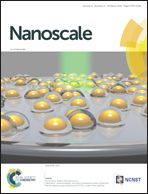Enhanced nucleation of germanium on graphene via dipole engineering†
Abstract
The preparation of crystalline materials on incommensurate substrates has been a key topic of epitaxy. van der Waals (vdW) epitaxy on two-dimensional (2D) materials opened novel opportunities of epitaxial growth overcoming the materials compatibility issue. Therefore, vdW epitaxy has been considered as a promising approach for the preparation of building blocks of flexible devices and thin film-based devices at the nano/microscale. However, an understanding of vdW epitaxy has not been thoroughly established. Especially, controlling nucleation during vdW epitaxy has not been achieved although nucleation in vdW epitaxy is suppressed due to the absence of surface dangling bonds on 2D materials. Here we show an enhancement of nucleation probability of germanium on graphene via introducing an out-of-plane dipole moment without any change in the chemical nature of graphene. A graphene/hexagonal boron nitride stack and transferred graphene on a polarized ferroelectric thin film were employed to demonstrate the significant enhancement of Ge nucleation on graphene. Theoretical calculations and chemical vapor deposition were employed to elucidate the effect of the out-of-plane dipole moment on nucleation in vdW epitaxy.



 Please wait while we load your content...
Please wait while we load your content...